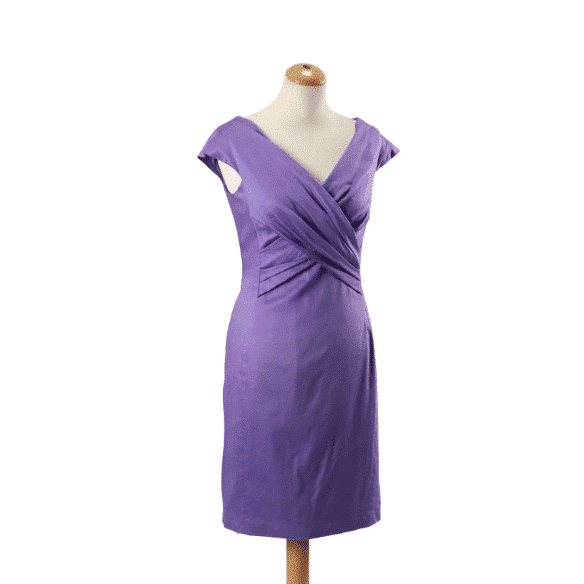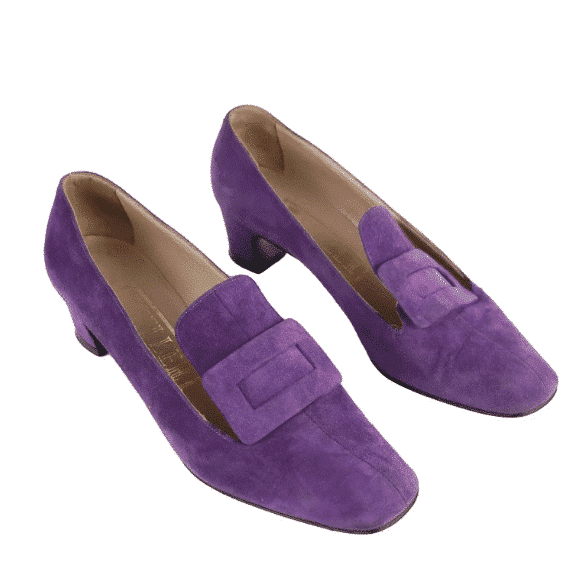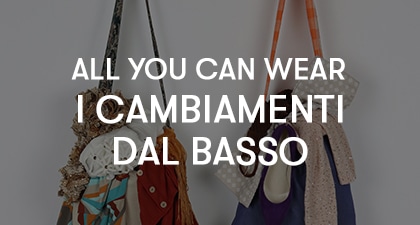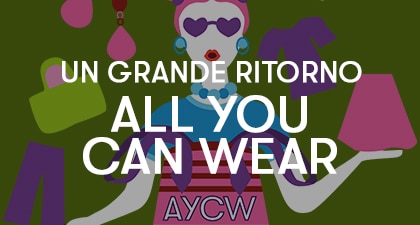
“I think it pisses God off if you walk by the color purple in a field somewhere and don’t notice it”, The Color Purple, Alice Walker.
It’s been a while since the last color we analyzed. So we’re excited to share with you some fascinating facts about one of the most elusive and interesting colors: purple.
Purple is created by blending red, symbolizing strength and power, with blue, representing sincerity and calmness. It’s a meeting of opposites and carries with it the characteristics of the colors from which it is derived.


Paola is wearing a total purple look (and vintage).
- Vintage dress, size XL, €40
- Vintage tie as a belt, €10
- Vintage sequin clutch, €25
- Vintage purple shoes, size 38, €60 (also available online at this link).
All items are currently available at the Cambiago store.
The Color of Royalty
In the West, purple represents royalty. Did you know that the first purple dye was produced by the ancient Romans using the mucus of certain sea snails? It took about twelve thousand snails to produce just a few grams of dye. Because of the difficulty of producing purple fabrics and their high cost, purple was rare and only the wealthy and powerful could afford to wear it.
It is said that Julius Caesar decreed that no one could wear purple except him. Similarly, Elizabeth I wore purple at her coronation in 1559, and her coffin was wrapped in purple fabric upon her death in 1603. These are just a few examples of its recurring significance in history.

The Color of Spirituality
Among the colors in the spectrum, purple has the shortest wavelength and is the last wavelength we can see. This connection to the boundaries of vision associates purple with a higher realm, the universe, and spirituality. Here, we see a deeper connection between royalty and purple: kings, queens, and emperors were considered representatives of God on Earth and believed to have superior power. Purple was costly, yes, but it also symbolized the divine and transcendent, making it a popular choice among nobility and rulers.

Purple is rare in nature compared to other colors. It appears in some flowers or during the transitional moments of the sky at sunset. It is the color associated with spiritual awareness, reflection, contemplation, and introspection. Other positive associations include love, wisdom, and self-mastery.
The negative traits of this color emerge, as always, from its excessive or misplaced use. Its qualities, when taken to extremes, can become irritating flaws such as being overly reflective, inconclusive, introverted, and developing a sense of inferiority.

The Seductive Violet
Purple is the typical color of the flower of the same name: the violet, a well-known flower that has among its qualities a minimalistic appearance combined with a captivating scent. For these characteristics, the violet is associated with seduction (Note: different from the impulsive sexuality of red). Seduction is the ability to evoke, to make one imagine, intrigue but never in a noisy way, rather in a measured and discreet manner.

When to Wear It
At work, dressing in or surrounding yourself with violet helps when we need time and concentration to complete a task.
As mentioned, violet is linked to the world of introspection. It is therefore the perfect color to wear when you meditate or pray, but not only. It helps to focus on a higher self but also communicates opulence and quality.
There are not many contraindications for this color, but as always, too much can spoil it. An excessive use of violet in clothing risks making us look ridiculous and not being taken seriously.

Craving Violet?
If you feel like adding a touch of violet to your wardrobe, here are some ideas directly from our site.



From left to right: Vintage Dior Monsieur Scarf, Moschino Purple Dress, Vintage YSL Paisley Blue/Purple Tie.



From left to right: Mercantia Earrings, Giorgio Armani Wool Scarf, Vintage Purple Heels.
Until the next color!
Bibliography:
Karen Haller, “The Little Book of Color”.








